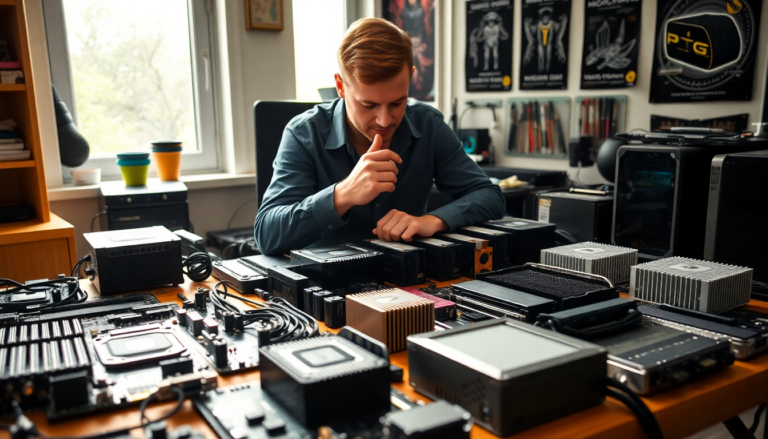Argomenti trattati
Understanding the importance of PC building history
It’s often said, “If you don’t know history, you’re bound to repeat it.” This adage rings true in many areas, including the world of PC building. Every enthusiast knows that the journey to create the perfect rig can be fraught with pitfalls. Many builders have shared their experiences online, cautioning others about the mistakes they made along the way. By understanding these common regrets, you can avoid similar missteps in your own PC building adventure.
The temptation of cheaper hardware
One of the most frequent regrets among PC builders is the allure of cutting costs by opting for cheaper hardware components. While saving money is always tempting, the performance trade-offs can be significant. For instance, investing in a modest graphics card may seem like a good idea initially, but if you later upgrade to a higher resolution monitor, you might find yourself unable to enjoy the improved visuals. This scenario often leads to frustration, as you realize that your budget-friendly GPU is holding you back from the gaming experience you desire.
It’s crucial to strike a balance between budget constraints and future needs. When planning your build, consider not only your current setup but also how it may evolve over time. A little foresight can save you from future regrets.
Do your research before making purchases
Another common regret stems from impulsive buying, particularly when it comes to newly released products. A recent example involved a builder who purchased a cutting-edge water-cooled heatsink, only for it to fail shortly after installation. Without thorough research, it’s easy to fall into the trap of purchasing hardware that hasn’t been vetted by user reviews. Early adopters often find themselves grappling with flaws that could have been avoided with proper caution.
In addition to researching product reliability, consider waiting a few weeks after a new release. This pause allows time for reviews and user feedback to accumulate, helping you make a more informed decision. By doing your due diligence, you not only increase your chances of a successful build but also spare yourself from unnecessary anxiety regarding the reliability of your components.
The importance of cooling in powerful builds
When building a high-performance PC, it’s easy to get caught up in the excitement of powerful CPUs and GPUs. However, one fundamental fact often overlooked is that PCs produce substantial heat. As the saying goes, “With great power comes great responsibility.” This holds particularly true for PC builders who must also prioritize effective cooling solutions.
Selecting a case with ample airflow and room for cooling components is essential. High-quality fans and cooling systems can make a significant difference in maintaining optimal performance and extending the lifespan of your hardware. Ensure that your build doesn’t just focus on performance but also incorporates proper thermal management, safeguarding your investment for years to come.
Buying all components together
While it might be tempting to purchase components gradually, this approach can lead to complications. Many seasoned builders recommend buying all parts at once, as this allows you to test compatibility and functionality within the warranty periods. Buying separately can result in overlap, where you may use components that are faulty or incompatible, thus voiding potential replacements later.
By consolidating your purchases, you can streamline the building process and minimize the risks of encountering issues later on. This approach not only saves time but also reduces the stress associated with troubleshooting compatibility problems.
The complexities of RGB lighting
RGB lighting can enhance the aesthetic appeal of your PC, but it comes with its own set of challenges. While vibrant LEDs can make your setup look stunning, they can also introduce a range of maintenance issues. From faulty LEDs to cable management nightmares, the potential problems associated with RGB setups can quickly become overwhelming.
Additionally, software that controls lighting effects can malfunction, leading to inconsistencies in appearance. It’s worth considering whether the visual appeal of RGB lighting outweighs the potential hassle of managing and maintaining such a setup. Sometimes, a minimalist approach can be just as visually appealing and significantly easier to manage.
Managing noise from fans
Loud fans are another often-overlooked aspect of PC building. While effective cooling is crucial, noisy fans can detract from your overall experience, particularly in shared living spaces. Many builders have expressed their frustration with fan noise, which can be distracting when trying to focus on gaming or work.
When selecting components, pay attention to noise levels. Investing in quieter fans or cooling solutions can significantly enhance your PC experience and improve your environment. After all, a well-balanced build is not just about performance; it’s also about enjoying the experience without unnecessary distractions.
By being mindful of these common regrets and challenges, you can navigate the world of PC building with greater confidence and satisfaction. Understanding the experiences of others can guide you in making informed decisions that lead to a successful and enjoyable build.

